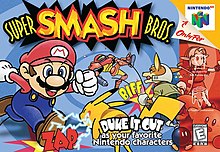
Kirby is the titular character and protagonist of the Kirby series of video games owned by Nintendo and HAL Laboratory. He first appeared in Kirby's Dream Land (1992), a platform game for the Game Boy. Since then, Kirby has appeared in over 50 games, ranging from action platformers to puzzle, racing, and even pinball, and has been featured as a playable character in every installment of the Super Smash Bros. series (1999–present). He has also starred in his own anime and manga series. Since 1999, he has been voiced by Makiko Ohmoto.
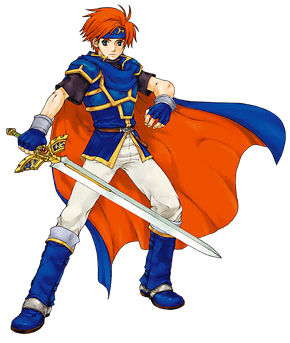
Roy is a fictional character from Nintendo and Intelligent Systems' Fire Emblem video game series, who first appeared in the 2001 crossover fighting game Super Smash Bros. Melee as a representative character from the Fire Emblem series, along with Marth. He is the lead character of Fire Emblem: The Binding Blade; within the story, he is the son of Eliwood and heir presumptive of Pherae, who eventually becomes a major military leader. The inclusion of Roy and Marth in Melee is cited as one of the reasons Nintendo started localizing the series for international distribution. Roy continues to make recurring appearances in subsequent Fire Emblem media, such as a manga series and spinoff video games.

Kirby's Dream Land is a 1992 platform video game developed by HAL Laboratory and published by Nintendo for the Game Boy. It is the first game in the Kirby series and marks the debut of Kirby. It introduced many conventions that would appear in later games in the series. The game follows Kirby as he goes through five levels to retrieve the Sparkling Stars and food of Dream Land from King Dedede.

Balloon Fight is an action video game developed by Nintendo and HAL Laboratory and published by Nintendo. The original arcade version was released for the Nintendo VS. System internationally as Vs. Balloon Fight, while its Nintendo Entertainment System counterpart was released in Japan in 1985 and internationally in 1986.

Ridley, also known by his aliases Geoform 187 and the Cunning God of Death, is a fictional supervillain and the main antagonist of the Metroid series. An evil and aggressive draconic extraterrestrial hailing from the planet Zebes, he became Samus Aran's archnemesis after murdering the latter's parents as he led a Space Pirate raid on her homeworld. Though having been destroyed numerous times by Samus, he is always resurrected, due in equal part to Space Pirate engineering and his natural regenerative ability, which allows him to swiftly recover from what would otherwise be fatal wounds as long as he is able to consume enough biomatter from his fallen adversaries.

Kirby Super Star, released as Kirby's Fun Pak in PAL regions, is an anthology platform video game developed by HAL Laboratory and published by Nintendo for the Super Nintendo Entertainment System in 1996. It is part of the Kirby series of video games by HAL Laboratory. The game was advertised as a compilation featuring eight games: seven short subsections with the same basic gameplay, and two minigames.

Masahiro Sakurai is a Japanese video game director and game designer best known as the creator of the Kirby and Super Smash Bros. series. Apart from his work on those series, he also led the design of Meteos in 2005 and directed Kid Icarus: Uprising in 2012.
Super Smash Bros. is a crossover platform fighting game series published by Nintendo. The series was created by Masahiro Sakurai, who has directed every game in the series. The series is known for its unique gameplay objective which differs from that of traditional fighters, in that the aim is to increase damage counters and knock opponents off the stage instead of depleting life bars.
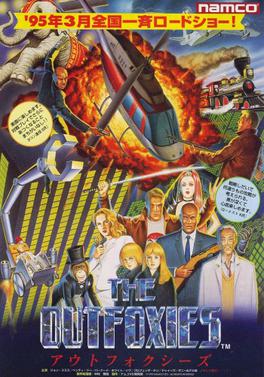
The Outfoxies is a 1995 weapon-based fighting arcade game developed and published in Japan by Namco. Controlling one of seven assassins, players are tasked with defeating opponents with different types of weapons, while also avoiding different obstacles brought on by various stage gimmicks. Weapons range from firearms such as pistols, machine guns and rocket launchers, to more outlandish items such as pie and bowls of hot soup. It runs on the Namco NB-2 arcade system.

Super Smash Bros. Brawl is a 2008 crossover fighting game developed by Sora Ltd. and Game Arts and published by Nintendo for the Wii. The third installment in the Super Smash Bros. series, it was announced at a pre-E3 2005 press conference by Nintendo president Satoru Iwata. Masahiro Sakurai, director of the previous two games in the series, assumed the role of director at Iwata's request. Game development began in October 2005 with a creative team that included members from several Nintendo and third-party development teams. After delays due to development problems, the game was released worldwide in 2008.

Little Mac is a fictional boxer and the protagonist in Nintendo's Punch-Out!! series of video games. He first appeared in the Arcade game Punch-Out!!. He is the smallest and youngest of all the boxers in the games, being only 17 years old across all Punch-Out!! games. His signature attack is the "STAR Punch". His design was changed for the SNES Super Punch-Out!!, but reverted to his original design in the Wii title. In the NES and Wii games, Little Mac is accompanied by Doc Louis, his trainer.

Super Smash Bros. Melee is a 2001 crossover fighting video game developed by HAL Laboratory and published by Nintendo for the GameCube. It is the second installment in the Super Smash Bros. series. It features characters from Nintendo video game franchises such as Mario, The Legend of Zelda, Star Fox, Pokémon, and Donkey Kong among others. The stages and gameplay modes reference or take designs from these franchises as well.

Kid Icarus: Uprising is a third-person shooter video game developed by Project Sora and published by Nintendo for the Nintendo 3DS. Released worldwide in March 2012, it is the third installment in the Kid Icarus franchise, the first to be released since Kid Icarus: Of Myths and Monsters in 1991, and the first worldwide release since the original NES game in 1986. It is also the only video game Project Sora made before shutting down in mid-2012.

Pit is a character and protagonist of the Kid Icarus series created by Nintendo. Pit is a resident of Angel Land and is a member of the royal guard tasked with the responsibility of defeating the ultimate evil. Pit made his debut in the original Kid Icarus (1986), with the mission to rescue the Goddess of Light, Palutena. Since then, she has become an adviser for him. Pit's other notable appearances include the Super Smash Bros. series, Captain N: The Game Master, WarioWare microgames, F1 Race, and Nintendo Entertainment System version of Tetris.
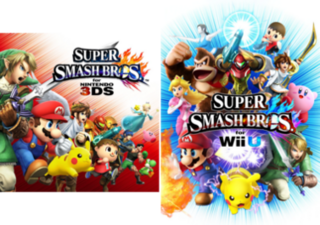
Super Smash Bros. for Nintendo 3DS and Super Smash Bros. for Wii U, both commonly referred together as Super Smash Bros. 4, are 2014 crossover platform fighter video games developed by Bandai Namco Studios and Sora Ltd. and published by Nintendo for the Nintendo 3DS and Wii U video game consoles. It is the fourth installment in the Super Smash Bros. series, succeeding Super Smash Bros. Brawl. The Nintendo 3DS version was released in Japan on September 13, 2014, and in North America, Europe, and Australia the following month. The Wii U version was released in North America, Europe, and Australia in November 2014 and in Japan the following month.

Super Smash Flash is a series of fighting browser games published by McLeodGaming, led by Gregory McLeod under the alias Cleod9. It is based on the Super Smash Bros series. The original Super Smash Flash is based specifically on Super Smash Bros. Melee. Its follow-up, also considered a reboot, is Super Smash Flash 2. The developer is currently working on an original crossover fighting game, Fraymakers.
Professional Super Smash Bros. competition involves professional gamers competing in the Super Smash Bros. series of crossover fighting games published by Nintendo. Organized tournament competition began in 2002 with Super Smash Bros. Melee, released for the GameCube in 2001; however, in the series' native Japan, there have been tournaments as early as 1999 with the original Super Smash Bros. for the Nintendo 64. Later tournaments have featured the other games in the series, with the two largest and most popular Smash Bros. scenes revolving around Melee and Super Smash Bros. Ultimate for the Nintendo Switch. Smaller scenes exist for the original game and Project M, a popular fan modification of Super Smash Bros. Brawl for the Wii, and to a lesser extent, Brawl itself. Major Smash Bros. tournaments include the GENESIS, Evolution Championship Series (EVO), Super Smash Con and The Big House annual series. Major League Gaming (MLG) has also previously included Smash Bros. games in its Pro Circuit.

Super Smash Bros. Ultimate is a 2018 crossover fighting game developed by Bandai Namco Studios and Sora Ltd. and published by Nintendo for the Nintendo Switch. It is the fifth installment in the Super Smash Bros. series, succeeding Super Smash Bros. for Nintendo 3DS and Wii U (2014). The game follows the series' traditional style of gameplay, in which players control one of the various characters and use attacks to weaken their opponents and knock them out of an arena. It features a wide variety of game modes, including a single-player campaign and multiplayer versus modes. Ultimate features 89 playable fighters, including all characters from previous Super Smash Bros. games as well as newcomers. The roster ranges from Nintendo characters to those from third-party franchises.
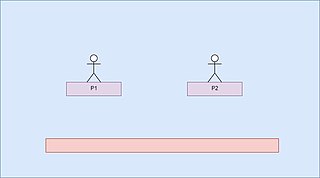
A platform fighter is a sub-genre of fighting games that emphasizes free 2D movement, often with floating platforms that can be traversed on, similar to a platformer game. The central gameplay involves combat between two or more player-controlled characters, with the goal of attacking an opponent's character until they are defeated.
